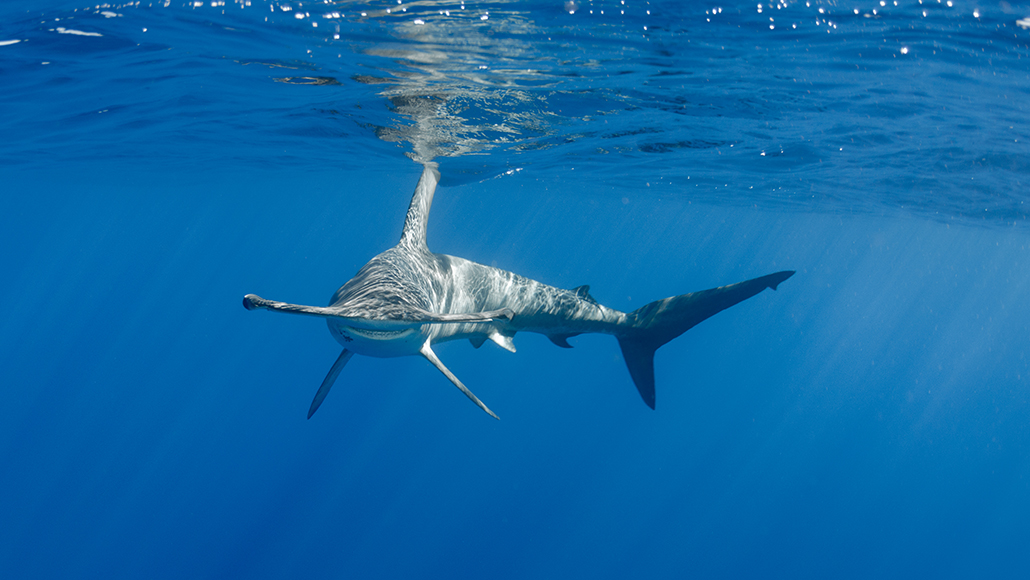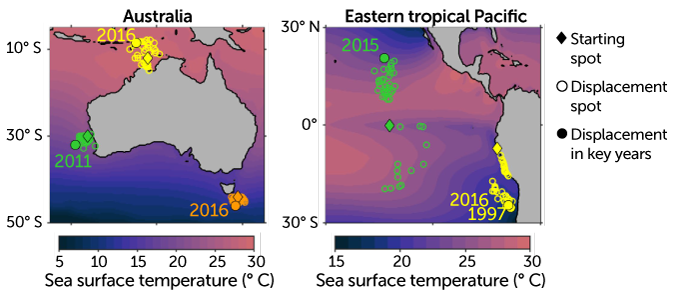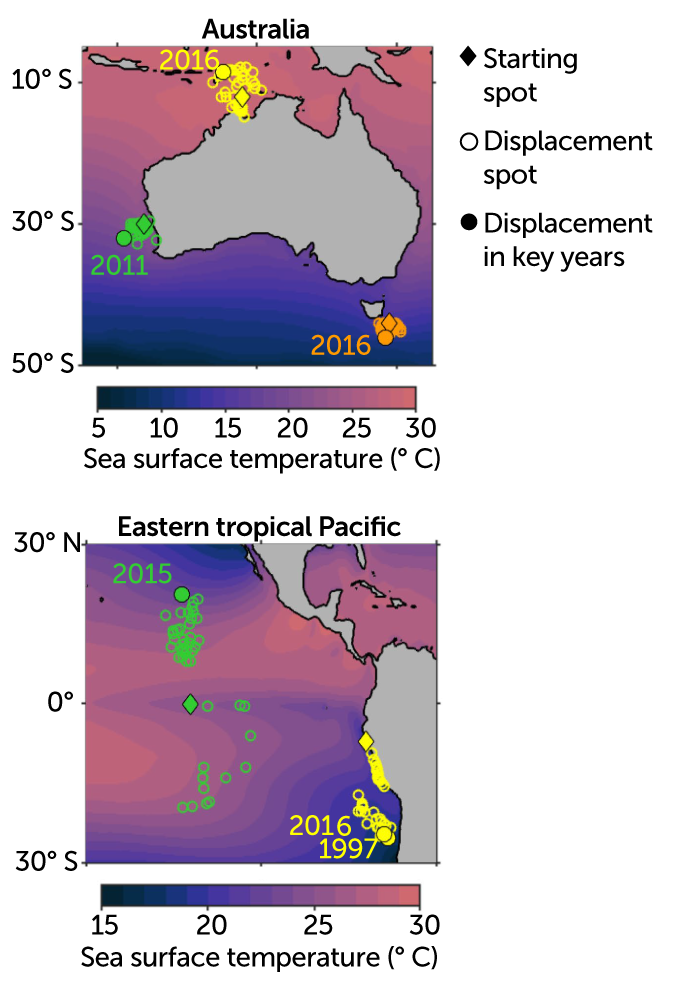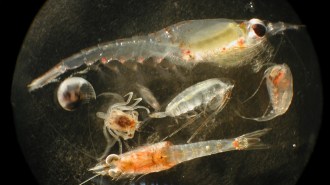
Hammerhead sharks, which normally range near Baja California, Mexico, were spotted hundreds of kilometers farther north during an intense marine heat wave in the tropical Pacific Ocean in 2015, known as the Blob.
Michael Zeigler/iStock/Getty Images Plus
- More than 2 years ago
When an intense heat wave strikes a patch of ocean, overheated marine animals may have to swim thousands of kilometers to find cooler waters, researchers report August 5 in Nature.
Such displacement, whether among fish, whales or turtles, can hinder both conservation efforts and fishery operations. “To properly manage those species, we need to understand where they are,” says Michael Jacox, a physical oceanographer with the National Oceanographic and Atmospheric Administration based in Monterey, Calif.
Marine heat waves — defined as at least five consecutive days of unusually hot water for a given patch of ocean — have become increasingly common over the past century (SN: 4/10/18). Climate change has amped up the intensity of some of the most famous marine heat waves of recent years, such as the Pacific Ocean Blob from 2015 to 2016 and scorching waters in the Tasman Sea in 2017 (SN: 12/14/17; SN: 12/11/18).
“We know that these marine heat waves are having lots of effects on the ecosystem,” Jacox says. For example, researchers have documented how the sweltering waters can bleach corals and wreak havoc on kelp forests. But the impacts on mobile species such as fish are only beginning to be studied (SN: 1/15/20).
“We have seen species appearing far north of where we expect them,” Jacox says. For example, in 2015, the Blob drove hammerhead sharks — which normally stay close to the tropics, near Baja California in Mexico — to shift their range at least hundreds of kilometers north, where they were observed off the coast of Southern California.
To see how far a mobile ocean dweller would need to flee to escape the heat, Jacox and colleagues compared ocean temperatures around the globe. First, they examined surface ocean temperatures from 1982 to 2019 compiled by NOAA from satellites, buoys and shipboard measurements. Then, for the same period, they identified marine heat waves occurring around the world, where water temperatures for a region lingered in the highest 10 percent ever recorded for that place and that time of year. Finally, they calculated how far a swimmer in an area with a heat wave has had to go to reach cooler waters, a distance the team dubs “thermal displacement.”
In hot water
The ocean waters around Australia (left) have seen numerous heat waves over the past few decades, including events off the west coast (green), the north (yellow) and in the Tasman Sea (orange), which were intensely damaging to kelp and corals. But more mobile species did not have to travel far from their original habitats (diamonds) to find cooler waters (open circles), even during the most extreme events (filled circles). By contrast, species had to travel farther to find relief from marine heat waves in the tropical Pacific Ocean (right). During the Blob from 2015–2016, some creatures may have traveled more than 2,000 kilometers.
Thermal displacement of marine species due to ocean heat waves, 1982–2019

The ocean waters around Australia (top) have seen numerous heat waves over the past few decades, including events off the west coast (green), the north (yellow) and in the Tasman Sea (orange), which were intensely damaging to kelp and corals. But more mobile species did not have to travel far from their original habitats (diamonds) to find cooler waters (open circles), even during the most extreme events (filled circles). By contrast, species had to travel farther to find relief from marine heat waves in the tropical Pacific Ocean (bottom). During the Blob from 2015–2016, some creatures may have traveled more than 2,000 kilometers.
Thermal displacement of marine species due to ocean heat waves, 1982–2019

In higher-latitude regions, such as the Tasman Sea, relief tended to be much closer, within a few tens of kilometers of the overheated patch, the researchers found. So while ocean heat waves in that region might spell doom for firmly rooted corals and kelp, mobile species might fare better. “We were surprised that the displacements were so small,” Jacox says.
But in the tropics, where ocean temperatures are more uniform, species may have had to travel thousands of kilometers to escape the heat.
Projecting how species might move around in the future due to marine heat waves gets increasingly complicated, the researchers found. That’s because over the next few decades, climate change is anticipated to cause not just an increase in frequency and intensity of marine heat waves, but also warming of all of Earth’s ocean waters (SN: 9/25/19). Furthermore, that rate of warming will vary from place to place. As a result, future thermal displacement could increase in some parts of the ocean relative to today, and decrease in others, writes marine ecologist Mark Payne of the Technical University of Denmark in Copenhagen, in a commentary in the same issue of Nature.
That complexity highlights the task ahead for researchers trying to anticipate changes across ocean ecosystems as the waters warm, says Lewis Barnett, a Seattle-based NOAA fish biologist, who was not involved in the study. The new work provides important context for data being collected on fish stocks. For example, surveys of the Gulf of Alaska in 2017 noted a large decline in the abundance of valuable Pacific cod, now known to be linked to the Blob heatwave that had ended the year before.
But there’s a lot more work to be done, Barnett says.
The study focuses on surface ocean temperatures, but ocean conditions and dynamics are different in the deep ocean, he notes. Some species, too, move more easily between water depths than others. And heat tolerance also varies from species to species. Biologists are racing to understand these differences, and how hot waters can affect the life cycles and distributions of many different animals.
The effects of marine heat waves might be ephemeral compared with the impacts of long-term climate change. But these extreme events offer a peek into the future, says Malin Pinsky, a marine ecologist at Rutgers University in New Brunswick, N.J., who was not involved in the study. “We can use these heat waves as lessons for how we’ll need to adapt.”




